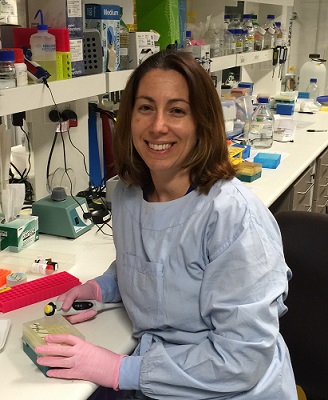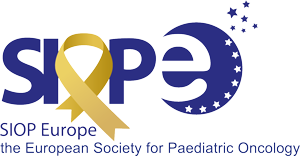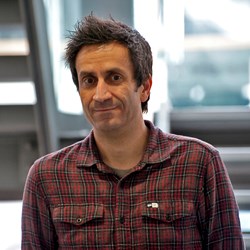Grants
The DIPG / DMG Collaborative has funded $19,023,550 in DIPG/DMG research.
Interested in applying for a grant from the DIPG / DMG Collaborative? Learn more.

Children's Cancer Institute - $145,341
$145,341.00
November 2015
Fenretinide, a novel agent targeting RTK/PI3K/AKT network for the treatment of Diffuse Intrinsic Pontine Glioma.
Diffuse Intrinsic Pontine Gliomas (DIPG) are the most aggressive of all childhood cancers. They are a type of brain tumour that peak in incidence at 5-7 years of age and are the most common form of malignant glioma to affect children. There are absolutely no effective treatments and current therapeutic strategies are palliative only. Due to their location within the brainstem the tumours cannot be removed surgically, they do not respond to chemotherapy, and radiotherapy only slows their growth temporarily. Novel and innovative treatment approaches are therefore urgently needed. In collaboration with Prof Monje (Stanford University, USA) and Dr Montero-Carcaboso (Saint John of God Foundation, Spain) we have established 7 neurosphere-forming DIPG cells and used these to perform the first ever high-throughput drug screen (HTS) of 3,500 bioactive pharmaceutical compounds. This screen has identified fenretinide as having significant activity against the DIPG cultures. Fenretinide is a synthetic retinoid that is well characterized, well tolerated in children and has been tested in the treatment of adult and paediatric cancers. It has never previously been assessed for the treatment of DIPG. The exact mechanism of action of fenretinide-induced cell death isn’t completely understood. However it has been suggested that its cytotoxic effects might be initiated by retinoic acid receptor (RAR) dependent and independent mechanisms. Furthermore it has been found to cause accumulation of reactive oxygen species (ROS) and lipid second messengers resulting in cell death through apoptosis. Our preliminary experiments have identified that fenretinide significantly inhibits proliferation of DIPG neurospheres and induces apoptosis. Furthermore we have found that ponatinib a multi-RTK inhibitor significantly enhances the cytotoxicity of fenretinide. Surprisingly we have made the novel discovery that fenretinide inhibits phosphorylation of receptor tyrosine kinases (RTK) including PDGFRa, RET and downstream targets of the Phosphoinositide 3 kinase (PI3K)/AKT pathway. Combination treatment with ponatinib, leads to enhanced suppression of this tumorigenic pathway. These findings indicate that DIPG cells are sensitive to pharmacological inhibition of RTK/PI3K/AKT pathway and that fenretinide represents an exciting new therapeutic strategy for DIPG. We seek here to build upon these initial findings, and to develop the preclinical evidence required to urgently translate these novel discoveries to clinical trial to directly benefit children with DIPG. We are currently investigating the mechanism of action of fenretinide and intend to evaluate whether its efficacy can be further enhanced with other anticancer drugs and RTK/PI3K/AKT inhibitors. Our aims are to assess the efficacy of fenretinide as a single agent and with the two most advantageous combinations in two animal models of DIPG. In doing so, we aim to develop the quantum of preclinical data required to rapidly translate this therapy from the bench to the bedside. Our team has all the necessary expertise that will ensure the success of the proposed project and ultimately the implementation of the discoveries into the clinic. Dr Maria Tsoli is a senior postdoctoral researcher with particular expertise in DIPG cell culture and xenograft models, cancer cell biology, drug discovery, computer simulations and has been involved together with Dr Ziegler in the co-supervision of a PhD student who has provided the preliminary data described in this project. Dr Ziegler has preclinical expertise in paediatric malignant brain tumours and his clinical focus on early phase clinical trials will facilitate translation of positive results to the bedside. Drs Monje and Montero-Carcaboso will continue to assist in providing DIPG cell cultures, and two DIPG animal models for performing the in vivo validations. The support of Dr Ziegler and Prof Haber at the Children’s Cancer Institute provides an invaluable environment to ensure the success of this novel research program, and with the ultimate goal of improving outcomes for children diagnosed with DIPG.

Cincinnati Children's Hospital Medical Center - $200,000
$200,000.00
October 2015
Intra-tumoral heterogeneity in diffuse intrinsic pontine and midline high-grade gliomas
Background: Diffuse intrinsic pontine glioma (DIPG) is a lethal pediatric brain tumor that affects approximately 150 children in North America each year.1 Though radiation therapy can prolong survival by 2-3 months, adjuvant chemotherapy has not improved outcome. The median survival is less than 12 months and has remained unchanged for the last 30 years.3 Knowledge of the pathogenesis of DIPG has been historically limited by lack of tissue availability, as diagnostic biopsy has not been routinely performed due to safety concerns.2 More recently, however, tissue procurement through autopsy programs3-5 and slowly growing acceptance of the safety of DIPG biopsy6-9 has provided the tissue necessary to gain critical knowledge of the genetic and epigenetic landscape of DIPG and has enabled development of in vitro and in vivo models through which novel therapies may be thoroughly tested.10,11
Since 2012, high-throughput sequencing studies have yielded unprecedented insight into the biologic basis of pediatric high-grade glioma (HGG) and DIPG.12-18 Midline, non-brainstem HGGs harbor a genomic profile akin to DIPG (e.g. frequent H3K27M mutation) and carry a similarly dismal prognosis.16,19 Mutations of chromatin remodeling genes H3F3A, HIST1H3B, and HIST1H3C are present in ~80% of thalamic HGGs19 and 70-96% of DIPGs.4-9 More recently discovered ACVR1 mutations are found in ~25% of DIPGs. In addition, mutations in other canonical cancer pathways, including (RTK)-RAS-PI3K, TP53, and RB1, are commonly found in HGG and DIPG.15,20 Unfortunately, our vastly improved understanding of tumor biology has not yet translated into a therapeutic breakthrough for children with HGG and DIPG. One critical factor that will significantly impact guiding appropriate therapy is histologic and molecular intra-tumoral heterogeneity. Although such heterogeneity has been well-documented in adult HGG21-23, there is little understanding of intra-tumoral variation in pediatric HGG and DIPG. Studies of DIPG at autopsy, including our own investigations with correlative post-mortem MRI, have revealed distant tumor metastases to the periventricular and frontal brain regions.5,24 Interestingly, we have observed some histologic variability between primary and distant tumor. Preliminary WES of primary, contiguous, and metastatic sites from 8 patients in our cohort also revealed relevant genomic heterogeneity (Figure 2). Although histone mutations, if present in the primary site, were detected at all disseminated sites, several interesting variations were seen among other clinically relevant mutations. Specifically, in one patient (patient 3) with six regions sequenced (all containing H3.3K27M), we detected regional variations in TP53 mutations. The primary tumour site (primary pons) contained a TP53 p.Arg248Gln alteration (allele frequency, AF = 0.46). Only 1 of 5 contiguous and metastatic sites (leptomeningeal spread) contained this alteration at an AF of 0.10. These 5 sites also harbored a TP53 p.Arg.275His alteration, which was not detected in the primary pons. In this same patient, a PDGFRA p.Glu229Lys alteration and ~8 copy amplification was detected in the right posterior pons, but not the primary pons or any other contiguous and metastatic sites. The leptomeningeal component did exhibit a PDGFRA copy number gain of ~4 copies. We hypothesize that genomic heterogeneity exists within the primary tumor and between primary and distant disease and that better understanding of clonal evolution of DIPG and midline HGG will guide the rational design of molecularly targeted therapies for these lethal brain tumors. Specific Aim 1: To define spatial intra-tumoral heterogeneity using WES on contiguous, non-contiguous, and distant metastatic sites in DIPG and midline HGG obtained at autopsy Specific Aim 2: To demonstrate patterns of branched clonal evolution of DIPG and midline HGG using high-depth WES on contiguous, non-contiguous, and distant metastatic sites Specific Aim 3: To define temporal intra-tumoral heterogeneity using WES on matched biopsy and autopsy tumor specimens from patients with DIPG and midline HGG
Methods/Budget: We request $200,000 to perform WES on matched primary and metastatic (n=10) and matched biopsy and autopsy (n=3) specimens from patients with DIPG or midline HGG who underwent surgical biopsy and/or autopsy at Cincinnati Children’s Hospital Medical Center (CCHMC) or The Hospital for Sick Children. A portion of funding will go toward salary support for the study PIs and for bioinformatics analyses. Complete clinical annotation is available for all patients. Clinical Significance: Characterization of spatial and temporal heterogeneity and establishment of clonal evolutionary patterns in DIPG and midline HGG will have significant clinical impacts. First, this work will define the utility of primary tumor biopsy, which may misrepresent targetable genomic lesions across all disease locations, and a potential role for re-biopsy at progression. Additionally, exploration of early somatic events using high-depth sequencing and phylogenetic analyses has potential to define true disease “drivers” common across disease compartments that, if molecularly targeted, may hold more potent therapeutic potential.

The Hospital for Sick Children - $190,905
$190,905.00
October 2015
Mitochondrial DNA alterations and their potential as a novel therapeutic target in DIPG
Brain tumors are the leading cause of cancer-related death in childhood. Diffuse intrinsic pontine glioma (DIPG) arises in the pons of the brainstem and is universally fatal, comprising nearly 15% of all pediatric brain tumors.1 Despite international endeavors to improve outcome, DIPGs show poor response to conventional radiation and chemotherapeutic strategies used in adults.2 Only within the last decade have studies really begun to describe differences between adult and pediatric diseases, underscoring the need for better targeted therapies. Most recently, our group made a major breakthrough in the understanding of DIPG biology by identifying three molecular subgroups: MYCN, Silent and H3K27M.3 The MYCN subgroup has no recurrent mutations but is characterized by chromothripsis on chromosome 2p leading to amplification of MYCN and ID2. The Silent subgroup is featured by a lower mutation rate and fewer copy number alterations than the other two subgroups. The H3K27M subgroup is the largest and harbors a K27M mutation in either H3F3A (H3.3) or the HIST1H3 family (H3.1). These findings highlight the potential importance of epigenetic dysregulation in DIPG pathogenesis. However, H3K27M tumors harbor additional alterations while MYCN and Silent subgroup tumors have relatively fewer recurrent genetic alterations, strongly suggesting that H3K27M alone is likely insufficient to drive malignant transformation. Additional mechanisms, including those beyond the traditional epigenetic and genetic modifications within the nuclear genome (nDNA), are likely to be required. Unlike normal cells that rely primarily on mitochondrial oxidative phosphorylation (OXPHOS) to generate the energy needed for cellular processes, cancer cells depend on aerobic glycolysis to support their uncontrolled growth even in the presence of ample oxygen, a phenomenon termed “the Warburg effect.”4 Abnormal OXPHOS and aerobic metabolism as a result of mitochondrial dysfunction are considered robust metabolic hallmarks of many cancer entities. Numerous somatic mutations in the mitochondrial genome (mtDNA) as well as mtDNA copy number changes have been increasingly observed across a broad spectrum of primary malignancies, including adult brain tumors.5 Mounting evidence has demonstrated that mtDNA sequence and content variations are associated with neoplastic transformation, tumor progression and metastasis, chemo/radioresistance, and disease prognosis.6 Due to decreased expression of mtDNA-encoded polypeptides and compromised function of respiratory enzyme complexes, either qualitative or quantitative alterations in mtDNA could elicit a decline in mitochondrial respiratory activity and cause persistent defects in the OXPHOS system accompanied by generation of excessive reactive oxygen species (ROS). This in turn further damages mtDNA, accelerates its mutational rate, and eventually establishes a vicious cycle amplifying mitochondrial dysfunction and oxidative stress. This scenario has been proposed to positively contribute to cancer initiation and/or progression.5,6 Despite a huge explosion of DIPG genomic and transcriptomic data and tremendous efforts in characterizing the biological significance of recurrent mutations in nDNA, to date, no study has investigated mtDNA mutations and copy number changes in DIPG or their potential as therapeutic targets. We hypothesize that mtDNA alterations and consequent impairment of mitochondrial and OXPHOS functions by themselves or in a cooperative fashion with nDNA mutations are important for the initiation and/or progression of DIPG. Work proposed in this study aims to screen pathogenic “driver” mutations in the entire mitochondrial genome of DIPG tumors by harnessing the advantage of targeted next-generation sequencing (NGS) technology and to elucidate the molecular mechanisms underlying their involvement in DIPG carcinogenesis (Aim 1). The potential to exploit altered mtDNA copy number as a novel therapeutic target in DIPG will be evaluated in Aim 2. This preclinical work will determine if manipulating mtDNA copy number or stimulating mitochondrial biogenesis is capable of rescuing the metabolic function of defective mitochondria in DIPG and thus reverse the malignant phenotype. Targeted whole mitochondrial genome sequencing may lead to the identification of a set of frequent mtDNA mutations that may play a primary and causative role in DIPG development. Our innovative approach of targeting aberrant mtDNA content in combination with conventional therapies will provide clues for designing novel therapeutic strategies. Our group is a leader in the field of DIPG and being part of the largest pediatric neuro-oncology team in Canada and active contributors in the DIPG collaborative, we are ideally situated to translate discoveries made through this project into novel early diagnostic tools and more effective therapeutic trials for this devastating disease.

Children's National Medical Center - $200,000
$200,000.00
October 2015
Evaluating TORC1/2 kinase inhibition in murine and nonhuman primate (NHP) models
Scientific Merit: New therapies are desperately needed for children with DIPG. Our group participated in recent collaborative efforts that led to identification of panobinostat as an active agent in DIPG. However, additional agents are likely required in combination with panobinostat to improve long-term survival for these children. We identified mutations activating the mTOR signaling pathway in DIPGs. Our preliminary data shows that targeting mTOR using a dual TORC 1/2 inhibitor, MLN0128, suppresses DIPG growth and increases apoptosis. Our strong collaborative team will use existing available preclinical resources, including four primary DIPG lines, xenograft and allograft DIPG models, and a non-human primate model, to test DIPG response to MLN0128 and evaluate the CNS pharmacokinetics of this agent. Combinational (radiation, panobinostat) therapies will be used to assess additional impact. Our approach is based on solid preliminary data that will be further expanded using three strongly collaborating laboratories for establishing mTOR as a potential target for treating DIPGs. The clinical need, widespread activation of mTOR in DIPG, and availability of a potent drug that penetrates into the central nervous system argue for further studies of MLN0128 in DIPG. Disease Impact: The proposed project aims to explore development of a new therapeutic for DIPG. In the short-term, the investigation of MLN0128 as a therapeutic agent in DIPG will provide the pre-clinical data to support a clinical trial of this agent, potentially in conjunction with radiation/chemotherapy. Once we have the data generated by our studies, we aim to perform a clinical trial of this agent based upon a sound biological and pharmacokinetic rationale. Innovation: 1. First study to investigate MLN0128 in DIPG. 2. Use of nonhuman primate (NHP) model to study drug pharmacokinetics. a. Unique ability to concurrently sample plasma and CSF penetration at multiple time points in primates. 3. Comprehensive in vitro and in vivo analysis of MLN0128 and combinatory treatments. 4. Identification of molecular mechanism of sensitivity/insensitivity to MLN0128 treatment. 5. Potential for near future clinical assessment of MLN0128 for treating children with DIPG. Feasibility: PIs of the proposed project have generated preliminary data indicating feasibility of the proposed project. Upregulation of mTOR is a known path by which cells develop resistance to panobinostat, therefore we propose to test the TORC1/2 kinase inhibitor MLN0128 in DIPG. MLN0128 has been shown by the pediatric preclinical testing program (PPTP) to have significant activity against the D456 brain tumor xenografts. We have demonstrated MLN0128’s activity against atypical tertoid/rhaboid brain tumor orthotopic xenografts, indicating that the agent does penetrate thebrain. Proposed molecular, in vitro and in vivo studies are routine in designated laboratories. MLN0128 is currently being tested in adult GBM. MLN0128 is available through CTEP, meaning that the drug could potentially be available for pediatric clinical trials. As such we envision our proposed study will result in robust molecular justification for using this compound in treating DIPGs. Expertise: Dr. Nazarian (PI) at CNHS has extensive expertise studying the molecular profiling (mRNA, methylation, proteomics) of DIPGs. CNHS houses cutting-edge genomic, proteomic and preclinical testing murine facilities. Dr. Raabe (Co-PI) a pediatric oncologist at Johns Hopkins University School has extensive experience in cell culture, molecular biology, immunochemical analysis and xenografting. Dr. Raabe’s laboratory had developed a primary DIPG line (JHH DIPG1) extensively used for preclinical testing across many laboratories. Dr. Katherine Warren (Co-PI) is the head of Pediatric Neuro-Oncology Section at NCI. Dr. Warren has extensive pharmacologic expertise, and leads preclinical and clinical efforts in developing new therapeutic strategies for the treatment of children with tumors of the central nervous system.

European DIPG Registry - $445,870.12
$445,870.00
September 2015
European DIPG Registry.
Childhood Oncology Group (DCOG), a National Paediatric Haematology[Oncology Society (NaPHOS) member of SIOPE. DCOG is mandated by the Executive Committee of the SIOPE DIPG Network to act as a legal entity on its behalf in matters concerning the DIPG Registry. The Parties acknowledge and agree that DCOG has no individual decision making authority with respect to the allocation of the funds in relation to the SIOPE DIPG Registry. DCOG shall have no responsibility or liability with respect to the distribution of the funding received under this agreement, except for any damages resulting from DCOGs gross negligent or intentional acts.
The responsibilities of DCOG include:
• conclude on behalf of the DIPG Registry written agreements with regard to Funds received from third parties for the DIPG Registry
• receive, administer and allocate all Funds for the DIPG Registry in accordance with the reasonable instructions of the Executive Committee.
• conclude written agreements with third parties providing services to the DIPG Registry, including but not limited to such agreement with the DIPG Imaging Repository
• conclude on behalf of the DIPG Registry written agreements with scientific advisors based on the model agreement attached to the Bylaws as Annex 2.
• invoice third parties on behalf of and as instructed by Executive Committee where appropriate
• pay invoices received from DIPG Network coordinators, third party service providers and other third parties in relation with any agreements executed by or for the DIPG Network in relation to the DIPG Registry as approved by the Executive Committee;
• DCOG shall ensure transparent book[keeping in relation to the DIPG Registry’s financial administration.
• any responsibilities agreed between the Executive Committee and DCOG, pursuant to the decision making procedures of the DIPG Network.

Institute of Cancer Research - $99,470
$99,470.00
September 2015
The Evolutionary Dynamics of Diffuse Intrinsic Pontine Glioma.
Diffuse intrinsic pontine glioma are high grade glial tumours arising in the brainstem with a median survival of 9-12 months, and a distinct biology compared to similar looking tumours arising in the cerebral hemispheres in children and adults. A major challenge to improve outcomes for these tumours is their extensive intratumoral heterogeneity, reflected by differing cellular morphologies and genomic imbalances present within an individual sample. We sought to define the subclonal diversity of DIPG with a view to better understanding the evolutionary dynamics underlying this variation.
In the first year of this grant, generously funded by the Abbie’s Army and the DIPG Collaborative, we have made substantial progress in ascertaining the subclonal architecture of DIPG using next-generating sequencing of single, multi-region and longitudinal samples. We have additionally developed methodology to isolate DIPG subclones in vitro in order to determine how distinct genotypes link to function within the tumour mass. As highlighted in the original application, we are now requesting a second year of funding to more fully explore the interactions between subclonal populations of DIPG cells, and to assess the possibilities of disrupting communication between subclones as a novel therapeutic strategy.

Stanford University Medical Center - $200,000
$200,000.00
September 2015
Targeting neuronal activity-regulated DIPG infiltration
DIPG is characteristically infiltrative (i.e. diffuse and intrinsic), and this infiltrative/invasive behavior is destructive both in the brainstem and in other areas of the central nervous system to which DIPG spreads during the course of the disease. In work previously funded by the Cure Starts Now and the DIPG Collaborative, we discovered that neuronal activity promotes DIPG cell invasion through activity-regulated secreted factors that includes an endogenous antagonist to the Nogo receptor (NgR). NgR signaling is a key mechanism that restricts the plasticity and regeneration of normal brain cells, and blocking the Nogo pathway results in increased motility of cells and cellular processes such as axonal outgrowth. In the normal brain, this signaling pathway plays a role during early brain development and may continue to play a role in ongoing brain plasticity. DIPG cells express NgR and in preliminary studies we have found that blocking NgR signaling with recombinant antagonist or by deleting the NgR gene via CRISPR gene editing from patient-derived DIPG cells dramatically increases DIPG invasion in vitro. In the proposed studies, we will expand these observations to a larger number of patient-derived DIPG cell cultures to determine how universal this mechanism may be, and will assess the importance of NgR signaling to DIPG invasion in vivo using genetic models. If NgR signaling proves to be an important mechanism controlling DIPG invasion, then stimulating the NgR receptor may be an innovative therapeutic strategy to control infiltration of DIPG cells throughout the brainstem and prevent spread more diffusely to the cerebrum and spinal cord.
The regulation of the NgR signaling by neuronal activity represents one of the many ways that experience shapes brain development and plasticity. The effects on DIPG invasion represents yet another way that DIPG cells hijack normal mechanisms of brain development to promote disease progression. Ultimately, by understanding the ways DIPG subverts mechanisms of childhood brain development and adaptability, we hope to develop effective and tumor-specific strategies to disrupt the ability of the tumor cells to use these crucial signals in the tumor microenvironment.

International DIPG Registry - $699,935
$699,935.00
August 2015
Establishment of an International Diffuse Intrinsic Pontine Glioma (DIPG) Registry
Diffuse intrinsic pontine gliomas (DIPG) are the most common brainstem tumors in children, representing approximately 75-80% of all pediatric brainstem tumors. 1 Approximately 200-300 patients are diagnosed with DIPG in all of North America and Europe. 1,2 DIPG accounts for 10-15% of all new pediatric brain tumor diagnoses and is the leading cause of brain tumor-related death in children.1 The median age at diagnosis is 6 to 7 years 2-4 and prognosis for patients with DIPGs remains dismal with a median survival of less than 1 year. Although radiotherapy does improve neurological function and survival by 2-3 months, no effective chemotherapeutic regimens are currently available.1,2 Achieving cure for all children with DIPG remains a major goal of pediatric neuro-oncology. In this application, we propose the expansion of the International Diffuse Intrinsic Pontine Glioma Registry which is now the largest and most comprehensive collection of data including clinical, radiologic and pathologic data linked to a bioinformatics repository of molecular data from a diverse cohort of DIPG patients available to researchers throughout the world. With the generous support of a coalition of pediatric brain tumor foundations from the DIPG Collaborative, and collaborations with 106 academic medical centers in the US, Canada, Australia, New Zealand, Egypt, Brazil, Chile, China, Argentina, India, Japan, Saudi Arabia, United Arab Emirates, and Lebanon, the Registry is growing exponentially. From April 2012 to August 2018, 885 patients diagnosed with DIPG have been enrolled from 106 collaborating institutions. The specific aims include: 1) To continue recruitment of patients diagnosed with DIPG in the International DIPG Registry to greater than 1,000 patients and further expand internationally; 2) To provide a repository of integrated data set compromised of clinical, pathologic, radiologic and molecular features to the clinical research community for promotion of hypothesis generation and analysis and maintain follow up on all cases; 3) To facilitate conduct of autopsies and sharing of fresh tissue for establishment of in vitro and in vivo models by investigators to be shared with investigators around the world; 4) To expand the bioinformatics repository of existing molecular data on DIPGs that can be linked to patient information in the registry through the Links and Viva platform to include prospective data; 5) To develop a program focused on quality of life through a longitudinal study where patient and/or parent proxy-dyads who enroll on the International DIPG Registry will complete Health related quality of life measures at specified time intervals and aid in supportive management; 6) To broaden collaborations among investigators for hypothesis-driven research studies through the registry that will ultimately lead to better classification and more effective treatment of patients with DIPG. In the next year, the International DIPG Registry investigators will promote robust collaborative research projects on all aspects of DIPG, and will continue to make the International DIPG Registry data available to external investigators after review of the proposed research by Scientific Advisory Committee (SAC). Our long-term goal is to expand on the highly collaborative, international, hypothesis-driven research infrastructure to continue to support a wide spectrum of interdisciplinary and translational projects in DIPGs for all investigators. The data collected form a research continuum from basic biology to clinical practice that will ultimately address our primary goals of a) understanding the biology of DIPGs, b) developing more effective therapies and c) developing innovative approaches to diagnosis, response assessment and multidisciplinary treatment and follow-up that will improve patient outcome in addition to maximizing quality of life.

Stanford University - $50,000
$50,000.00
April 2015
Tumor Associated Microglia in Diffuse Intrinsic Pontine Glioma
Diffuse high-grade gliomas are a class of central nervous system tumors that carry a dismal prognosis across all ages. In children, about half of these tumors arise within the ventral pons as diffuse intrinsic pontine glioma (DIPG), which has a peak incidence from ages 6-8 and only a 9-12 month median survival. The consistent timing and location of this tumor suggests that specific developmental cues in the microenvironment of the mid-childhood ventral pons may be dysregulated. Microglia, the resident macrophages of the brain, represent both a component of the normal developmental microenvironment and also a potential contributor to pathologic microenvironments such as DIPG. Tissue macrophages are critical in the development of other organs (Pollard, 2009), and recent studies suggest that microglial trophic factors play a role in development and learning (Ueno et al., 2013; Parkhurst et al., 2013). In adult gliomas, macrophages can make up 30-50% of the tumor mass and are implicated as supporting angiogenesis and tumor cell invasion, proliferation, and survival (Glass & Synowitz, 2014). In contrast to adult gliomas, however, strikingly little is known about how microglia and macrophages contribute to the pediatric high-grade glioma microenvironment. Given the possible role of microglia in normal brain development, an intriguing hypothesis is that these pediatric gliomas hijack normal supportive roles of microglia to promote tumor growth and invasion. Understanding this interaction in molecular detail will provide insight not only into the pathophysiology of DIPG and possible adjuvant therapeutic targets, but also into the possible roles of microglia in normal brain development.
This research proposal seeks to elucidate the mechanisms through which microglia interact with DIPG. Previous work demonstrated that inhibition of colony stimulating factor-1 signaling in macrophages in a murine glioblastoma model can block glioma progression (Pyonteck et al., 2013). Moreover, recent evidence suggests that adult glioblastomas secrete the soluble factor periostin, which attracts macrophages and directs them to promote tumor growth (Zhou et al., 2015). In primary DIPG tissue samples, there is a high degree of microglial staining (Figure 1, Caretti et al., 2014), which suggests that these cells play an important role in shaping the DIPG microenvironment. Determining how this microglial role differs in DIPG compared to adult gliomas will provide a better understanding of the role of microglia in the unique midchildhood pontine microenvironment.
We hypothesize that pontine microglia promote DIPG growth through secreted growth factors, and we propose to test this hypothesis through the following aims:
1) Demonstrate how pontine microglia affect DIPG behavior at baseline and in various states of activation.
2) Identify the molecular signals that underlie microglial
effects on DIPG proliferation.
3) Determine what pathways are activated in DIPG by microglial-secreted factors.
CD68

University of California, San Francisco - $100,000
$100,000.00
September 2014
Single-cell profiling and targeting of developmentally regulated signaling programs in DIPG.
Background: As in other malignant gliomas, there is evidence that DIPG is organized as an aberrant developmental hierarchy originating from rare, treatment-resistant tumor-initiating cells (TICs), also referred to as “cancer stem cells”. Although TICs are potentially important drug targets, they are a challenge to study directly because these cells comprise a minor subset of the tumor, and prospective identification (i.e. by surface markers) is imperfect. Moreover, prospective identification of TICs is controversial, with various groups in the glioma field advocating different markers (i.e. CD133, Nestin, Sox2, integrin 6, etc.), and variability from patient-to-patient. Over 75% of DIPG tumors harbor mutations in histone H3.3 that cause global dysregulation of epigenetic marks, including H3K27me3 and CpG methylation. These epigenetic changes manifest as uncontrolled growth of cells with molecular features of pontine gliogenesis. However, the inducible and constitutively active signaling programs downstream of these epigenetic changes – and their coordination with other markers of glial differentiation – are not well understood.
Hypothesis: We hypothesize that developmentally distinct subpopulations of DIPG tumor cells rely on distinct signaling networks to maintain cell survival, and that more effective therapies can be achieved by precisely targeting these signaling programs.
Goals: To characterize developmentally regulated signaling pathways in DIPG, and to test whether targeted disruption of these pathways improves survival in xenograft models.
Design and methods: The technology enabling this study is a next-generation flow cytometry platform (‘mass cytometry’) that enables the simultaneous measurement of up to 32 antibody-based markers at the single-cell level. Mass cytometry presents opportunities to clarify phenotypic identification of developmentally distinct subsets in DIPG, including TICs, and at the same time make direct observations intracellular signaling behavior. Specific Aim 1 uses mass cytometry to map the “developmental trajectory” of pediatric DIPG by tracking the phenotypic changes along the path from primitive TICs to their more differentiated progeny. We will use phospho-specific antibodies to profile the constitutively active and inducible growth-factor signaling pathways in tumor cells along the developmental trajectory, at the single-cell level. Specific Aim 2 takes a chemical genetics approach to further elucidate the developmentally regulated signaling programs in DIPG. We will use a library of 368 well-characterized pharmacologic inhibitors to disrupt growth factor signaling and pro-survival pathways in DIPG. The results of this screen will complement information from Aim 1, to help us pinpoint the developmentally regulated signaling mechanisms in DIPG. In the final stage of this Aim, we will test promising drug candidates for the ability to improve survival in vivo using DIPG orthotopic xenografts.
Innovation: The epigenetic programs enforced by histone H3 mutations appear to lock cells in an oncogenic state, but the consequences at the level of cellular signaling and differentiation are essentially unexplored. We propose to employ mass cytometry, a powerful new technology that allows us, for the first time in pediatric glioma, to simultaneously characterize cellular phenotype and signaling behavior at the single-cell level,
Clinical significance: There is an urgent need for new therapies for DIPG. This study will lead to improved understanding of the relationship between intratumor heterogeneity and oncogenic signaling pathways in DIPG, and will test putative targeted therapies that leverage those new insights.

VU University Medical Center - $30,529
$30,529.00
September 2014
European DIPG Registry
Childhood Oncology Group (DCOG), a National Paediatric Haematology[Oncology Society (NaPHOS) member of SIOPE. DCOG is mandated by the Executive Committee of the SIOPE DIPG Network to act as a legal entity on its behalf in matters concerning the DIPG Registry. The Parties acknowledge and agree that DCOG has no individual decision making authority with respect to the allocation of the funds in relation to the SIOPE DIPG Registry. DCOG shall have no responsibility or liability with respect to the distribution of the funding received under this agreement, except for any damages resulting from DCOGs gross negligent or intentional acts.
The responsibilities of DCOG include:
• conclude on behalf of the DIPG Registry written agreements with regard to Funds received from third parties for the DIPG Registry
• receive, administer and allocate all Funds for the DIPG Registry in accordance with the reasonable instructions of the Executive Committee.
• conclude written agreements with third parties providing services to the DIPG Registry, including but not limited to such agreement with the DIPG Imaging Repository
• conclude on behalf of the DIPG Registry written agreements with scientific advisors based on the model agreement attached to the Bylaws as Annex 2.
• invoice third parties on behalf of and as instructed by Executive Committee where appropriate
• pay invoices received from DIPG Network coordinators, third party service providers and other third parties in relation with any agreements executed by or for the DIPG Network in relation to the DIPG Registry as approved by the Executive Committee;
• DCOG shall ensure transparent book[keeping in relation to the DIPG Registry’s financial administration.
• any responsibilities agreed between the Executive Committee and DCOG, pursuant to the decision making procedures of the DIPG Network.

Institute of Cancer Research - $95,325
$95,325.00
September 2014
The evolutionary dynamics of DIPG
Diffuse intrinsic pontine glioma are high grade glial tumours arising in the brainstem with a median survival of 9-12 months, and a distinct biology compared to similar looking tumours arising in the cerebral hemispheres in children and adults. A major challenge to improve outcomes for these tumours is their extensive intratumoral heterogeneity, reflected by differing cellular morphologies and genomic imbalances present within an individual sample. We aim to define the subclonal diversity of DIPG with a view to better understanding the evolutionary dynamics underlying this variation. Firstly, we will use high-depth sequencing to explore the subclonal architecture of a series of DIPG specimens. We will generate direct evidence of subclonal diversity by longitudinal studies of biopsy/autopsy pairs for which multiple topographically distinct samples are available post-mortem. We will further explore the functional consequences of this heterogeneity by studying single cell-derived colonies derived from primary tumour specimens in vitro, using advanced high-throughput image analysis linked to targeted resequencing. The long-term goal of such an approach is to provide a framework for preclinical testing of evolutionary biologydriven combinatorial therapies, and to generate data to underpin novel, rationally designed clinical trials in these currently untreatable diseases.

The Hospital of Sick Children - $99,400
$99,400.00
September 2014
Development of subgroup-specific models of paediatric DIPG
Brain tumors are the largest group of solid tumors and the leading cause of cancer-related deaths in childhood1. The most devastating of these is DIPG, an incurable brainstem tumor with a median survival of less than one year2,3. DIPGs show poor response to conventional radiation and chemotherapeutic strategies used in adults. Only within the last decade have studies really begun to describe differences between the adult and pediatric disease, underscoring the need for better therapies targeted to the pediatric disease. Most recently, our group reported a major breakthrough in our understanding of DIPG biology with the identification of three molecular subgroups of DIPG4: MYCN, Silent and H 3K27M. The MYCN subgroup has no r ecurrent mutations but is instead characterized by DNA hypermethylation, high grade histology, and chromothripsis on chromosome 2p leading to recurrent high level amplification of MYCN and ID2. The Silent subgroup is characterized by silent genomes with a lower mutation rate than the other two subgroups. The H3K27M subgroup is the largest, and all DIPGs in this subgroup harbor a mutation in either H3F3A or HIST1H3B. In addition, this group is characterized by highly unstable genomes, global DNA hypomethylation and co-occurrence of additional genetic alterations including PDGFRA amplification and ACVR1, PIK3CA and TP53 mutations. Discovery of three molecular subgroups has revolutionized our thinking about the pathogenesis of DIPG6-8 and highlighted the importance of epigenetic dysregulation during tumorigenesis, although it is still unclear which of these alterations represent feasible therapeutic targets. We hypothesize that combined expression of frequent, subgroup-specific, gene alterations in mouse neural stem cells will result in the dysregulation of normal cellular processes, ultimately leading to malignant transformation. In this study we will elucidate the interactions between frequently altered genes in each of the DIPG subgroups and the mechanisms underlying their role in tumorigenesis through two specific aims: 1. Transformation of mouse neural stem cells using lentiviral delivery of genetic alterations associated with each of the three DIPG subgroups. 2. Development of new mouse models of each DIPG subgroup that can be used for pre-clinical drug testing. Co-expression of subgroup-specific alterations in mouse neural stem cells will allow us to systematically determine the effect of individual alterations on normal cellular processes and their ability to induce malignant transformation and/or maintain the malignant phenotype. Subsequent injection of the mouse neural stem cell lines into the brainstem of immunocompromised mice will enable us to conclude which combination of alterations is both necessary and sufficient for tumor formation and maintenance in vivo. We will then remove the mutant histone to test whether this is important for tumor maintenance in vivo and could thus serve as a therapeutic target. These experiments will inform production of subgroup-specific transgenic mouse models for DIPG and address a gap in the development of successful DIPG clinical trials. Development of accurate preclinical mouse models of DIPG is crucial to understanding why current therapies fail and for identifying novel drugs that can effectively treat children suffering from this devastating disease. Our group is a leader in the field of DIPG and we are well poised to translate discoveries made through this project into novel and more successful therapeutic trials for this fatal disease.

Duke University Medical Center - $85,394
$85,394.00
November 2013
Development of peptide vaccine for diffuse intrinsic pontine glioma
Hypothesis- Our hypothesis is that a peptide vaccination targeting H3.3K27M will be an effective tumor-specific therapy for patients with gliomas expressing this mutation, without antigen escape or toxicity.
Goals- To identify an effective therapy that will prolong the survival of children with DIPG. We will pursue the following two specific aims:
1. To design an H3.3K27M peptide vaccine and determine if it is immunogenic. 2. To determine if H3.3K27M peptide vaccine can significantly prolong the survival of H3.3K27M mutant DIPG-bearing mice.
Background- Diffuse intrinsic pontine glioma is a type of brain cancer that arises in children and is incurable. Recently K27M mutations were described in H3.1 and H3.3 in up to 80% of human DIPGs.
Clinical Significance DIPG is an incurable tumor. We are proposing to explore a new therapeutic strategy by developing a peptide vaccine against the mutant histone, a tumor specific antigen. Successful completion of this project will provide the scientific rationale for a clinical trial of a peptide vaccine for children with DIPG whose tumors harbor the H3.3K27M mutation (60% of children with DIPG).
Design and Methods of the proposed study- This proposal brings together two labs: the Becher lab and the Sampson lab. The Becher lab has expertise in genetically engineered mouse models of DIPG and the Sampson lab has expertise with the development of peptide vaccines for gliomas. Aim 1 will be performed in the Sampson lab and Aim 2 will be performed in the Becher lab. Aim 1- To design an H3.3K27M peptide vaccine and determine if it is immunogenic. We propose to develop and test a vaccine consisting of a peptide encompassing the mutant amino acid- methionine substituting for a lysine. Our peptide design will be a 25-mer and will be called PEPH3.3K27M. The mutant amino acid is highlighted 15APRKQLATKAARMSAPSTGGVKKPH39. The control 25-mer peptide will be called PEP-H3.3WT: 15APRKQLATKAARKSAPSTGGVKKPH39. We will vaccine mice at day 1, 7, 14 and on day 21 and assess the immune response by IFNγ ELISpot to wild type and mutant peptides.
Aim 2- To determine if H3.3K27M peptide vaccine can significantly prolong the survival of H3.3K27M mutant DIPG-bearing mice. we propose to test the efficacy of the PEP-H3.3K27M peptide vaccine in mice bearing H3.3K27M mutant DIPGs. Cohorts will receive intradermal PEP-H3.3K27M vaccination or intradermal PEP-H3.3WT vaccination at the tail base once weekly for three weeks starting at 3 weeks post injection of virusproducing cells (postnatal D3-4). If we do not observe significant efficacy, we will then attempt strategies designed to overcome these barriers such as T-cell immunomodulatory agents (lymphodepletion with temozolomide) and/or adjuvants (KLH).

Yale University - $100,000
$100,000.00
November 2013
Pre-Clinical Development of Novel DIPG Radiosensitizers
Hypothesis: Diffuse intrinsic pontine glioma (DIPG) is a devastating disease with an almost universally fatal prognosis. Despite many clinical trials testing numerous chemotherapies and targeted systemic agents, both concurrent with RT and in the adjuvant setting, these therapies have not changed OS. We and others believe that 3 major issues contribute to the poor response to therapy in DIPG patients treated with RT and concurrent systemic therapies. First, drug penetration into DIPG tumors is severely limited by the blood brain barrier. Second, many systemic therapies have been tested in DIPG based on extrapolation from adult high grade glioma trials, without a clear rationale for testing in this genetically distinct tumor type. Finally, the evidence underlying the radiosensitizing potential of many of these agents is lacking. We hypothesize that nanoparticlemediated and convection-enhanced (CED) drug delivery, coupled with the use of targeted radiosensitizers which have been validated in DIPG cells, will lead to higher rates of local control and consequent OS for this disease. As described below, we will test this hypothesis in a proposed one year pilot study focused on the pre-clinical development of novel DIPG radiosensitizers. Background: As noted above, DIPG is a devastating tumor, with most patients succumbing to their disease within 2 years after diagnosis. Focal RT is the only treatment which has shown a benefit in DIPG, although it extends OS by only ~3-4 months. Remarkably, numerous chemotherapy combinations, RT fractionation regimens, and novel systemic agents have been tested in DIPG, without any appreciable OS improvements in the last 30 years. In addition, many agents were tested in DIPG based on observed activity in adult GBM, and temozolomide (TMZ) is one example. Unfortunately, studies now confirm that TMZ is not effective in DIPG when added to standard RT. Given that virtually all DIPGs recur locally, there has been great interest in testing novel combinations of targeted systemic therapies with RT, as a means to enhance local control via radiosensitization. Examples include small molecules targeting Aurora Kinase B, VEGFR-2 and PDGFR. DSB repair pathways play critical roles in the response to IR, as highlighted by the exquisite radiosensitivity of cells from patients with inherited DSB repair defects. It is now known that key DNA damage and checkpoint genes are up-regulated in DIPG, including the Chk2 and WEE1 kinases, suggesting a role for DSB repair inhibition as a radiosensitization strategy. While these are promising strategies, recent studies suggest that the efficacy of DIPG therapies is severely limited by drug delivery, which suggests novel methods are needed to ensure adequate tumor targeting. Goals, Design and Methods: We have recently performed a high-throughput screen for novel DNA double-strand break (DSB) repair inhibitors, which led to the identification of several lead compounds with radiosensitizing activity in vitro. We propose to test these compounds as potential radiosensitizers in primary DIPG cells in vitro, and several of the most promising lead hits will then be encapsulated in nanoparticles to facilitate drug delivery into DIPGs in vivo. Finally, three molecules will be selected for testing as radiosensitizers in a DIPG xenograft mouse model in vivo. Clinical Significance: Our proposed studies have the potential to identify novel therapeutics which can be tested in DIPG patients, and they represent an important proof-of-principle, which can be used as the basis to test other drugs as novel DIPG radiosensitizers in the future. Research Team: This application brings together two new Principal Investigators (PI’s) from Yale Medical School, Bindra and Zhou, with complementary research expertise in DSB repair and nanoparticle drug delivery, respectively. Importantly, they share a common goal of developing novel therapeutics for the treatment of adult and pediatric high grade gliomas. Bindra is a physicianscientist in the Department of Therapeutic Radiology, with a clinical and research focus on pediatric CNS tumors, including DIPGs. His laboratory is developing cell-based screening approaches to identify novel radiosensitizers for high grade gliomas. He is particularly interested in eventually translating these discoveries into the clinical setting, via the development of investigator-initiated Phase I trials. Zhou is a translational scientist in the Department of Neurosurgery, with substantial experience in nanoparticle research and CNS drug delivery. His laboratory is focused on developing novel, nanoparticle-based drug delivery systems.